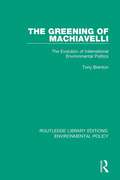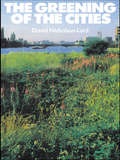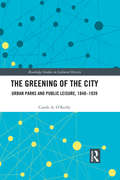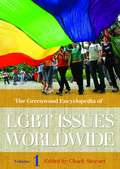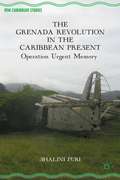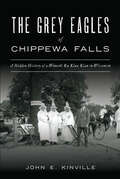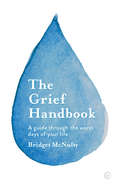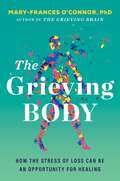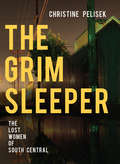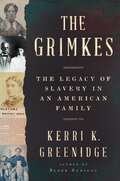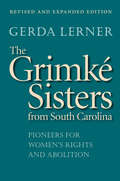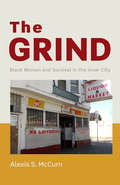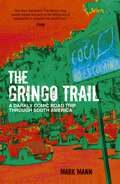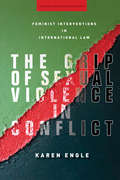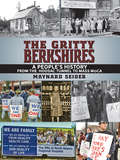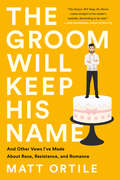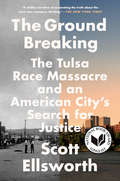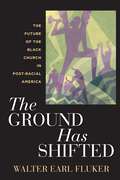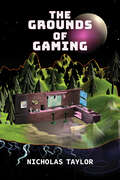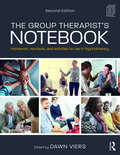- Table View
- List View
The Greening of America
by Charles A. ReichThere is a revolution coming. It will not be like revolutions of the past. It will originate with the individual and the with culture, and it will change the political structure only as its final act. It will not require violence to succeed, and it cannot be successfully resisted by violence. This is the revolution of the new generation.
The Greening of Machiavelli: The Evolution of International Environmental Politics (Routledge Library Editions: Environmental Policy #4)
by Tony BrentonFirst published in 1994. Environmental issues present a daunting challenge to the international system. The destruction of the tropical rainforest, the Chernobyl explosion and the ozone layer ‘hole’ all underline the transnational nature of environmental threats and the need for states to act together in order to tackle them. How have such environmental issues entered political agendas in different parts of the world and how has that affected national positions? Can governments ever reconcile their own national interests with the international cooperation needed to deal with transboundary issues such as climate change? This book traces the history of international environmental negotiations and regulations and looks at the domestic policies upon which cooperation in the international community depends. It covers some major milestones in recent history, from the Torrey Canyon accident through to the Rio ‘Earth Summit’ and the emergence of the European Community as a major international environmental actor. It also looks at cross-cutting issues such as the role of non-governmental organizations, the environmental impacts of world agriculture and trading arrangements, industry’s attitudes, and the relationship between democracy and environmental protection. It concludes by examining how the international system has adapted, and may adapt further, to deal effectively with environmental problems, and reflects on the implications of this for the future.
The Greening of the Cities
by David Nicholson-LordFirst Published in 2004. Routledge is an imprint of Taylor & Francis, an informa company.
The Greening of the City: Urban Parks and Public Leisure, 1840-1939 (Routledge Studies in Cultural History #73)
by Carole A. O'ReillyUrban parks are a much-loved feature of the city environment. However, our knowledge of the true scale of their impact remains uneven. Much work has been done on their origins and design features, but this book aims to extend this beyond the nineteenth century, examining the fuller flowering of these valuable spaces in the early decades of the twentieth century. Encompassing themes such as social and political usage, parks as employers and the dangers posed by such freely accessible spaces, the book examines a range of parks in cities such as Manchester, Salford, Liverpool, Leeds, Preston, Hull and Cardiff and challenges the prevailing myths about their meaning for their users. This study's timeframe spans almost 100 years of unprecedented social, cultural, political and economic changes and allows for the consideration of the expansion and commercialisation of leisure opportunities for the public. Urban parks played a significant role in this — the book places parks firmly in the context of the evolving city and examines the importance of green space to the urban citizen during this most fascinating of historical periods.
The Greenwood Encyclopedia of LGBT Issues Worldwide, Volume 1: The Americas and the Caribbean
by Chuck K. StewartThis set has an ambitious scope with the goal of offering the most up-to-date international overview of key issues in the lives of lesbian, gay, bisexual, and transgender individuals. HIV/AIDS has been a major media focus, but this set fosters a broader understanding of the status of LGBT individuals in their society. More than 70 countries are represented. The clear, accessible prose is appropriate for high school student research on up. The material is especially needed in a cultural climate that supports and informs about LGBT populations. The content is useful for a paper on a hot topic, health classes, discussion groups, and gay-straight alliance groups. This set has an ambitious scope with the goal of offering the most up-to-date international overview of key issues in the lives of lesbian, gay, bisexual, and transgender individuals. HIV/AIDS has been a major media focus, but this set fosters a broader understanding of the status of LGBT individuals in their society. More than 70 countries are represented. The clear, accessible prose is appropriate for high school student research on up. The material is especially needed in a cultural climate that supports and informs about LGBT populations. The content is useful for a paper on a hot topic, health classes, discussion groups, and gay-straight alliance groups.
The Greenwood Encyclopedia of LGBT Issues Worldwide, Volume 2: Europe
by Chuck K. StewartThis set has an ambitious scope with the goal of offering the most up-to-date international overview of key issues in the lives of lesbian, gay, bisexual, and transgender individuals. HIV/AIDS has been a major media focus, but this set fosters a broader understanding of the status of LGBT individuals in their society. More than 70 countries are represented. The clear, accessible prose is appropriate for high school student research on up. The material is especially needed in a cultural climate that supports and informs about LGBT populations. The content is useful for a paper on a hot topic, health classes, discussion groups, and gay-straight alliance groups.This set has an ambitious scope with the goal of offering the most up-to-date international overview of key issues in the lives of lesbian, gay, bisexual, and transgender individuals. HIV/AIDS has been a major media focus, but this set fosters a broader understanding of the status of LGBT individuals in their society. More than 70 countries are represented. The clear, accessible prose is appropriate for high school student research on up. The material is especially needed in a cultural climate that supports and informs about LGBT populations. The content is useful for a paper on a hot topic, health classes, discussion groups, and gay-straight alliance groups.
The Greenwood Encyclopedia of LGBT Issues Worldwide, Volume 3: Africa and the Middle East
by Chuck K. StewartThis set has an ambitious scope with the goal of offering the most up-to-date international overview of key issues in the lives of lesbian, gay, bisexual, and transgender individuals. HIV/AIDS has been a major media focus, but this set fosters a broader understanding of the status of LGBT individuals in their society. More than 70 countries are represented. The clear, accessible prose is appropriate for high school student research on up. The material is especially needed in a cultural climate that supports and informs about LGBT populations. The content is useful for a paper on a hot topic, health classes, discussion groups, and gay-straight alliance groups.This set has an ambitious scope with the goal of offering the most up-to-date international overview of key issues in the lives of lesbian, gay, bisexual, and transgender individuals. HIV/AIDS has been a major media focus, but this set fosters a broader understanding of the status of LGBT individuals in their society. More than 70 countries are represented. The clear, accessible prose is appropriate for high school student research on up. The material is especially needed in a cultural climate that supports and informs about LGBT populations. The content is useful for a paper on a hot topic, health classes, discussion groups, and gay-straight alliance groups.
The Grenada Revolution in the Caribbean Present
by Shalini PuriThe Grenada Revolution in the Caribbean Present: Operation Urgent Memory is the first scholarly book from the humanities on the subject of the Grenada Revolution and the US intervention. It is simultaneously a critique, tribute, and memorial. It argues that in both its making and its fall, the 1979-1983 Revolution was a transnational event that deeply impacted politics and culture across the Caribbean and its diaspora during its life and in the decades since its fall. Drawing together studies of landscape, memorials, literature, music, painting, photographs, film and TV, cartoons, memorabilia traded on e-bay, interviews, everyday life, and government, journalistic, and scholarly accounts, the book assembles and analyzes an archive of divergent memories. In an analysis that is relevant to all micro-states, the book reflects on how Grenada's small size shapes memory, political and poetic practice, and efforts at reconciliation.
The Grey Eagles of Chippewa Falls: A Hidden History of a Women's Ku Klux Klan in Wisconsin
by John E. KinvilleA women&’s chapter of the KKK in the early twentieth-century Midwest is uncovered in this fascinating and meticulously researched social history.In the xenophobic atmosphere of the 1920s and 1930s, Ku Klux Klan activity spiked in Wisconsin and gave rise to Women&’s Klan no. 14, also known as the Grey Eagles of Chippewa Falls. Against a national backdrop that saw the Klan hurl its collective might into influencing presidential elections and federal legislation, quotidian matters often stole the attention of the Grey Eagles. Drawing on never-before-seen materials, author John E. Kinville unfolds their complex legacy. For every minute spent upholding Prohibition and blocking Catholic Al Smith&’s path to the White House, the Grey Eagles spent two raising funds for their order and helping neighbors in need. What unfolds in Kinville&’s work is the complex legacy of these Chippewa Falls women who struggled to balance care for their community against the malicious ideology of the Klan.</
The Grief Handbook: A guide through the worst days of your life
by Bridget McNultyThe Grief Handbook will take you by the hand and offer empathy and compassion, helping you through what can feel like the worst days of your life.Bridget McNulty lost her mum suddenly. She couldn't find the support that she needed in the rawness of her immediate grief, and the loneliness felt profoundly shocking. The Grief Handbook weaves her personal experience with expert psychological insights and practical advice, to enable you to navigate your grief in your own way.There is no one-size-fits-all recovery process for bereavement. Understanding that each experience of grief is unique, you can stop worrying about how you should be feeling. This interactive journal offers you room to explore your feelings at your own pace, helping you not to shy away from the enormity of your heartbreak.To be able to move through grief we need to understand our emotions, tune into our needs and know that what we are feeling is normal. Grief isn&’t something to &“get over&”, but a loss to honour and live with. This gentle book shows us how
The Grieving Body: How the Stress of Loss Can Be an Opportunity for Healing
by Mary-Frances O'ConnorThe follow-up to celebrated grief expert, neuroscientist, and psychologist Dr. Mary-Frances O’Connor’s The Grieving Brain focuses on the impact of grief—and life’s other major stressors—on the human body. Coping with death and grief is one of the most painful human experiences. While we can speak to the psychological and emotional ramifications of loss and sorrow, we often overlook its impact on our physical bodies. Dr. Mary-Frances O’Connor specializes in the study of grief, and in The Grieving Body she shares vital scientific research, revealing imperative new insights on its profound physiological impact. As she did in The Grieving Brain, O’Connor combines illuminating studies and personal stories to explore the toll loss takes on our cardiovascular, endocrine, and immune systems and the larger implications for our long-term well-being.The Grieving Body addresses questions about how bereavement affects us, such as:Can we die of a broken heart?What happens in our bodies when we’re grieving?How do our coping behaviors affect our physical health?What is the cognitive impact of grief?Why are we more prone to illness during times of enormous stress?and moreResearch-backed, warm, and empathetic, The Grieving Body is an essential, hopeful read for those experiencing loss as well as their supportive friends and family.The Grieving Body is illustrated with black-and-white charts and graphs.
The Grim Sleeper: The Lost Women of South Central
by Christine PelisekThe inside story of one of the notorious and elusive serial killer who stalked the vulnerable, the young, and the ignored in 1980s Los Angeles—only to return in 2002.The Grim Sleeper was one of the most brutal serial killers in California history, preying on the women of South Central for decades. No one knows this story better than Christine Pelisek, the reporter who followed it for more than ten years. Based on extensive interviews, reportage, and information never released to the public, The Grim Sleeper captures the long, bumpy road to justice in one of the most startling true crime stories of our generation from his violent first crime while serving in the US Army to his inevitable death in prison."This upsetting account of a Los Angeles serial killer, written with passion by Christine Pelisek, an investigative crime reporter who spent 10 years working the case, blurts out a hard truth that no one wants to acknowledge . . . [She] tries to restore dignity to some of the victims by drawing sympathetic and carefully detailed life histories for each and every one of them." ―Marilyn Stasio, The New York Times Book Review
The Grimace of Macho Ratón: Artisans, Identity, and Nation in Late-Twentieth-Century Western Nicaragua
by Les FieldIn this creative ethnography Les W. Field challenges a post-Sandinista national conception of identity, one that threatens to constrict the future of subaltern Nicaraguans. Drawing on the works and words of artisans and artisanas, Indians, and mestizos, Field critiques the national ideology of ethnic homogeneity and analyzes the new forms of social movement that have distinguished late-twentieth-century Nicaragua. As a framework for these analytic discussions, Field uses the colonial-era play El Güegüence o Macho Ratón and the literature relating to it. Elite appropriations of El Güegüence construe it as an allegory of mestizo national identity in which mestizaje is defined as the production of a national majority of ethnically bounded non-Indians in active collaboration with the state. By contrast, Field interprets the play as a parable of cultural history and not a declaration of cultural identity, a scatological reflection on power and the state, and an evocation of collective loss and humor broadly associated with the national experience of disempowered social groups. By engaging with those most intimately involved in the performance of the play--and by including essays by some of these artisans--Field shows how El Güegüence tells a story about the passing of time, the absurdity of authority, and the contradictions of coping with inheritances of the past. Refusing essentialist notions of what it means to be Indian or artisan, Field explains the reemergence of politicized indigenous identity in western Nicaragua and relates this to the longer history of artisan political organization. Parting ways with many scholars who associate the notion of mestizaje with identity loss and hegemony, Field emphasizes its creative,productive, and insightful meanings. With an emphasis on the particular struggles of women artisans, he explores the reasons why forms of collective identity have posed various kinds of predicaments for this marginalized class of western Nicaraguans. This book will appeal to readers beyond the field of Latin American anthropology, including students and scholars of literature, intellectual history, women's studies, and the politics of ethnicity.
The Grimkes: The Legacy Of Slavery In An American Family
by Kerri K. GreenidgePublishers Weekly • 10 BEST BOOKS OF 2022 New York Times • "15 Works of Nonfiction to Read This Fall", Best Books of November 2022 Boston Globe • "20 New Books We're Most Excited to Read This Fall" A stunning counternarrative of the legendary abolitionist Grimke sisters that finally reclaims the forgotten Black members of their family. Sarah and Angelina Grimke—the Grimke sisters—are revered figures in American history, famous for rejecting their privileged lives on a plantation in South Carolina to become firebrand activists in the North. Their antislavery pamphlets, among the most influential of the antebellum era, are still read today. Yet retellings of their epic story have long obscured their Black relatives. In The Grimkes, award-winning historian Kerri Greenidge presents a parallel narrative, indeed a long-overdue corrective, shifting the focus from the white abolitionist sisters to the Black Grimkes and deepening our understanding of the long struggle for racial and gender equality. That the Grimke sisters had Black relatives in the first place was a consequence of slavery’s most horrific reality. Sarah and Angelina’s older brother, Henry, was notoriously violent and sadistic, and one of the women he owned, Nancy Weston, bore him three sons: Archibald, Francis, and John. While Greenidge follows the brothers’ trials and exploits in the North, where Archibald and Francis became prominent members of the post–Civil War Black elite, her narrative centers on the Black women of the family, from Weston to Francis’s wife, the brilliant intellectual and reformer Charlotte Forten, to Archibald’s daughter, Angelina Weld Grimke, who channeled the family’s past into pathbreaking modernist literature during the Harlem Renaissance. In a grand saga that spans the eighteenth century to the twentieth and stretches from Charleston to Philadelphia, Boston, and beyond, Greenidge reclaims the Black Grimkes as complex, often conflicted individuals shadowed by their origins. Most strikingly, she indicts the white Grimke sisters for their racial paternalism. They could envision the end of slavery, but they could not imagine Black equality: when their Black nephews did not adhere to the image of the kneeling and eternally grateful slave, they were cruel and relentlessly judgmental—an emblem of the limits of progressive white racial politics. A landmark biography of the most important multiracial American family of the nineteenth century, The Grimkes suggests that just as the Hemingses and Jeffersons personified the racial myths of the founding generation, the Grimkes embodied the legacy—both traumatic and generative—of those myths, which reverberate to this day.
The Grimké Sisters from South Carolina
by Gerda LernerA landmark work of women's history originally published in 1967, Gerda Lerner's best-selling biography of Sarah and Angelina Grimke explores the lives and ideas of the only southern women to become antislavery agents in the North and pioneers for women's rights. This revised and expanded edition includes two new primary documents and an additional essay by Lerner. In a revised introduction Lerner reinterprets her own work nearly forty years later and gives new recognition to the major significance of Sarah Grimke's feminist writings.
The Grind: Black Women and Survival in the Inner City
by Alexis S. McCurnFew scholars have explored the collective experiences of women living in the inner city and the innovative strategies they develop to navigate daily life in this setting. The Grind illustrates the lived experiences of poor African American women and the creative strategies they develop to manage these events and survive in a community commonly exposed to violence. Alexis S. McCurn draws on nearly two years of naturalistic field research among adolescents and adults in Oakland, California to provide an ethnographic account of how black women accomplish the routine tasks necessary for basic survival in poor inner-city neighborhoods and how the intersections of race, gender, and class shape how black women interact with others in public. This book makes the case that the daily consequences of racialized poverty in the lives of African Americans cannot be fully understood without accounting for the personal and collective experiences of poor black women.
The Gringo Trail: A Darkly Comic Road Trip through South America
by Mark MannMark Mann and his girlfriend Melissa set off to explore the ancient monuments, mountains and rainforests of South America. But for their friend Mark, South America meant only one thing: drugs. Sad, funny and shocking, The Gringo Trail is a darkly comic road-trip and a revealing journey through South America’s turbulent history.
The Grip of Sexual Violence in Conflict: Feminist Interventions in International Law (Stanford Studies in Human Rights)
by Karen EngleContemporary feminist advocacy in human rights, international criminal law, and peace and security is gripped by the issue of sexual violence in conflict. But it hasn't always been this way. Analyzing feminist international legal and political work over the past three decades, Karen Engle argues that it was not inevitable that sexual violence in conflict would become such a prominent issue. Engle reveals that as feminists from around the world began to pay an enormous amount of attention to sexual violence in conflict, they often did so at the cost of attention to other issues, including the anti-militarism of the women's peace movement; critiques of economic maldistribution, imperialism, and cultural essentialism by feminists from the global South; and the sex-positive positions of many feminists involved in debates about sex work and pornography. The Grip of Sexual Violence in Conflict offers a detailed examination of how these feminist commitments were not merely deprioritized, but undermined, by efforts to address the issue of sexual violence in conflict. Engle's analysis reinvigorates vital debates about feminist goals and priorities, and spurs readers to question much of today's common sense about the causes, effects, and proper responses to sexual violence in conflict.
The Gritty Berkshires: A People's History From The Hoosac Tunnel To Mass Moca
by Maynard SeiderAs The Gritty Berkshires makes clear, Massachusetts' westernmost county is not just art museums, music festivals and beautiful scenery. For generations of working class families who have lived in the northern part of this county, their reality looks more like Rust Belt America. Maynard Seider, an activist sociologist who has taught and researched in the area for more than three decades, places the history of the North Berkshire region in the context of U.S. and global history. Through the use of oral histories, union archives, newspaper accounts and participant observation, the author focuses on the 1,000 men who built the nation's longest railroad tunnel, the thousands of men and women who worked in its textile mills and electronics factories and who struck, built worker co-ops, and community coalitions to improve their daily lives. In this history, we learn how the Berkshires offer insight into so many crucial aspects of the American experience. Moving from the early 1800s to the present, Seider weaves a narrative that details the area's vibrant immigrant history, slavery's role in its textile industry, the battle for national unions and the ideological struggles with corporate elites over who best speaks for the community. Enriched by dozens of photographs, these stories focus on the voices of ordinary people as they often do extraordinary things. Seider concludes his book by considering the question of "What's next?" through a case study of the Massachusetts Museum of Contemporary Art (MASS MoCA). These brick buildings which housed generations of blue and white collar workers until 1986 now attract tourists to the country's largest contemporary art collection. Yet the unanswered question remains, can a tourist-service economy provide a meaningful and economically sustainable life for its residents? The Gritty Berkshires' last section deals with this question both nationally and locally, exploring diverse responses amidst the nation's growing inequality, militarism and cutbacks in social services.
The Groom Will Keep His Name: And Other Vows I've Made About Race, Resistance, and Romance
by Matt OrtileA riotous collection of "witty and captivating" (Bitch Magazine) essays by a gay Filipino immigrant in America learning that everything is about sex--and sex is about powerWhen Matt Ortile moved from Manila to Las Vegas, the locals couldn't pronounce his name. Harassed as a kid for his brown skin, accent, and femininity, he believed he could belong in America by marrying a white man and shedding his Filipino identity. This was the first myth he told himself. The Groom Will Keep His Name explores the various tales Ortile spun about what it means to be a Vassar Girl, an American Boy, and a Filipino immigrant in New York looking to build a home. As we meet and mate, we tell stories about ourselves, revealing not just who we are, but who we want to be. Ortile recounts the relationships and whateverships that pushed him to confront his notions of sex, power, and the model minority myth. Whether swiping on Grindr, analyzing DMs, or cruising steam rooms, Ortile brings us on his journey toward radical self-love with intelligence, wit, and his heart on his sleeve.
The Ground Between: Anthropologists Engage Philosophy
by Michael Jackson Veena Das Arthur Kleinman Bhrigupati SinghThe guiding inspiration of this book is the attraction and distance that mark the relation between anthropology and philosophy. This theme is explored through encounters between individual anthropologists and particular regions of philosophy. Several of the most basic concepts of the discipline--including notions of ethics, politics, temporality, self and other, and the nature of human life--are products of a dialogue, both implicit and explicit, between anthropology and philosophy. These philosophical undercurrents in anthropology also speak to the question of what it is to experience our being in a world marked by radical difference and otherness. In The Ground Between, twelve leading anthropologists offer intimate reflections on the influence of particular philosophers on their way of seeing the world, and on what ethnography has taught them about philosophy. Ethnographies of the mundane and the everyday raise fundamental issues that the contributors grapple with in both their lives and their thinking. With directness and honesty, they relate particular philosophers to matters such as how to respond to the suffering of the other, how concepts arise in the give and take of everyday life, and how to be attuned to the world through the senses. Their essays challenge the idea that philosophy is solely the province of professional philosophers, and suggest that certain modalities of being in the world might be construed as ways of doing philosophy.Contributors. João Biehl, Steven C. Caton, Vincent Crapanzano, Veena Das, Didier Fassin, Michael M. J. Fischer, Ghassan Hage, Clara Han, Michael Jackson, Arthur Kleinman, Michael Puett, Bhrigupati Singh
The Ground Breaking: An American City and Its Search for Justice
by Scott EllsworthOne of Oprah Daily's 20 of the Best Books to Pick Up This May | One of The Oklahoman's 15 books to help you learn about the Tulsa Race Massacre as the 100-year anniversary approachesAnd then they were gone. More than one-thousand homes and businesses. Restaurants and movie theaters, churches and doctors&’ offices, a hospital, a public library, a post office. Looted, burned, and bombed from the air. Over the course of less than twenty-four hours in the spring of 1921, Tulsa&’s infamous &“Black Wall Street&” was wiped off the map—and erased from the history books. Official records were disappeared, researchers were threatened, and the worst single incident of racial violence in American history was kept hidden for more than fifty years. But there were some secrets that would not die. A riveting and essential new book, The Ground Breaking not only tells the long-suppressed story of the notorious Tulsa Race Massacre. It also unearths the lost history of how the massacre was covered up, and of the courageous individuals who fought to keep the story alive. Most importantly, it recounts the ongoing archaeological saga and the search for the unmarked graves of the victims of the massacre, and of the fight to win restitution for the survivors and their families. Both a forgotten chronicle from the nation&’s past, and a story ripped from today&’s headlines, The Ground Breaking is a page-turning reflection on how we, as Americans, must wrestle with the parts of our history that have been buried for far too long.
The Ground Has Shifted: The Future of the Black Church in Post-Racial America (Religion, Race, and Ethnicity #6)
by Walter Earl Fluker&“An exuberant, thought-provoking assessment of the dilemmas facing black churches&” examining their historic role in today&’s cultural landscape (Publishers Weekly, starred review). In The Ground Has Shifted, Walter Earl Fluker discusses the historical and current role of the Black church and argues that the older race-based language and metaphors of religious discourse have outlived their utility. He offers instead a larger, global vision for the Black church that focuses on young Black men and other disenfranchised groups who have been left behind in a world of globalized capital. Lyrically written with an emphasis on the dynamic and fluid movement of life itself, Fluker argues that the church must find new ways to use race as an emancipatory instrument if it is to remain central in Black life. He points the way for a new generation of church leaders, scholars and activists to reclaim the Black church&’s historical identity and to turn to the task of infusing character, civility, and a sense of community among its congregants.Honorable Mention, Theology and Religious Studies PROSE Award
The Grounds of Gaming (Digital Game Studies)
by Nicholas TaylorHow do we make space for video games in the places where we live, work, and play—and who is allowed to feel welcome there? Despite attempts to expand games beyond their conventional audience of young men, the physical contexts of gameplay and production remain off-limits and unsafe for so many.The Grounds of Gaming explores the physical places where games are played and how they contribute to the persistence of gaming's problematic politics. Drawing on fieldwork in an array of sites, author Nicholas Taylor explores the real-world settings where games are played, watched, discussed and designed. Sometimes these places are sticky, dark, and stinky; other times they are pristine and well appointed. Situating its chapters in such scenes as domestic gaming setups, campus computer labs, LAN parties, esports arenas, and convention centers, Taylor maps the infrastructural connections between games, place, masculinity, and whiteness.By inviting us to reconsider gaming's cultural politics from the ground up, The Grounds of Gaming offers new theoretical insights and practical resources regarding how to make game cultures and industries more inclusive.
The Group Therapist's Notebook: Homework, Handouts, and Activities for Use in Psychotherapy
by Dawn ViersFollowing in the footsteps of the successful first edition, The Group Therapist’s Notebook, Second Edition offers an all new collection of innovative ideas and proven interventions that will enhance any group therapy practice. Seasoned and up-and-coming experts provide field-tested activities, easy to reproduce handouts, and practical homework assignments for a variety of problems and population types. Each chapter is solidly grounded with a theoretical foundation and includes materials to gather for implementing the intervention, detailed instructions for use, suggestions for follow-up in successive meetings, contraindications for use, and resources for the client and therapist. With an added emphasis on instruction, real-world examples, and extension activities, this new resource will be a valuable asset for both beginning and established mental health practitioners, including counselor educators, social workers, marriage and family therapists, guidance counselors, prevention educators, peer support specialists, and other group facilitators.

